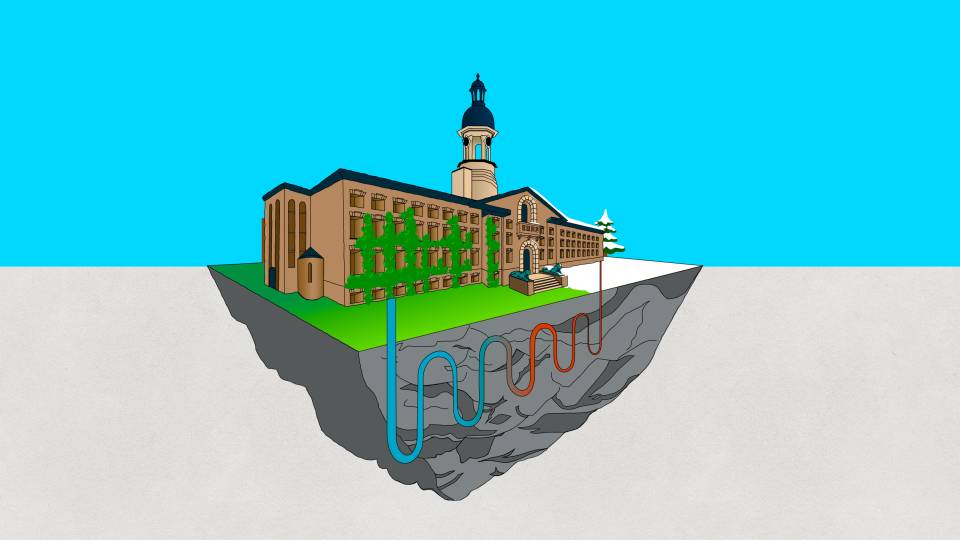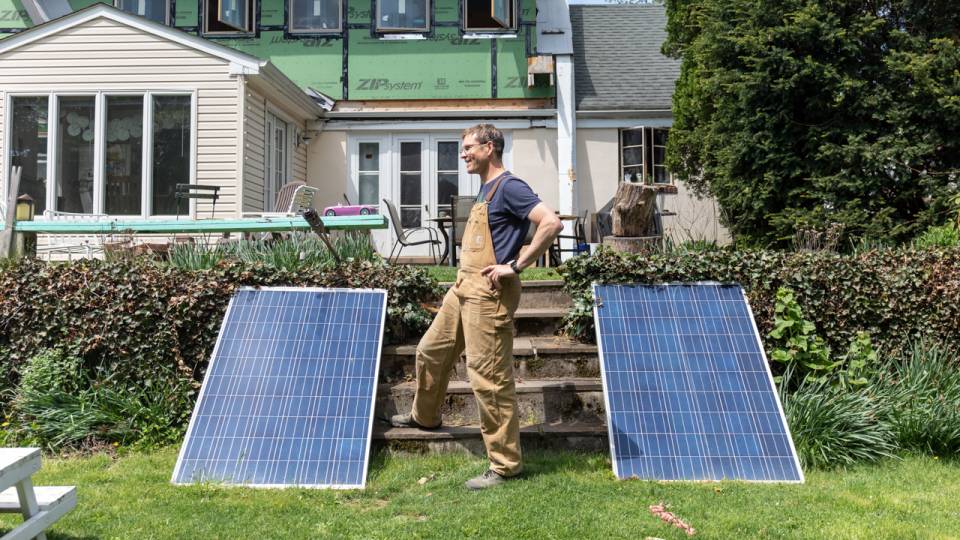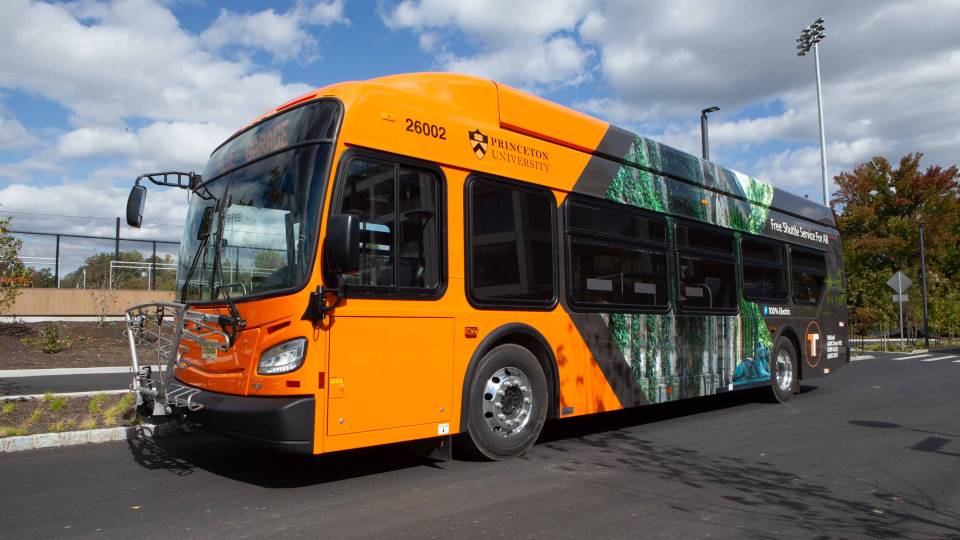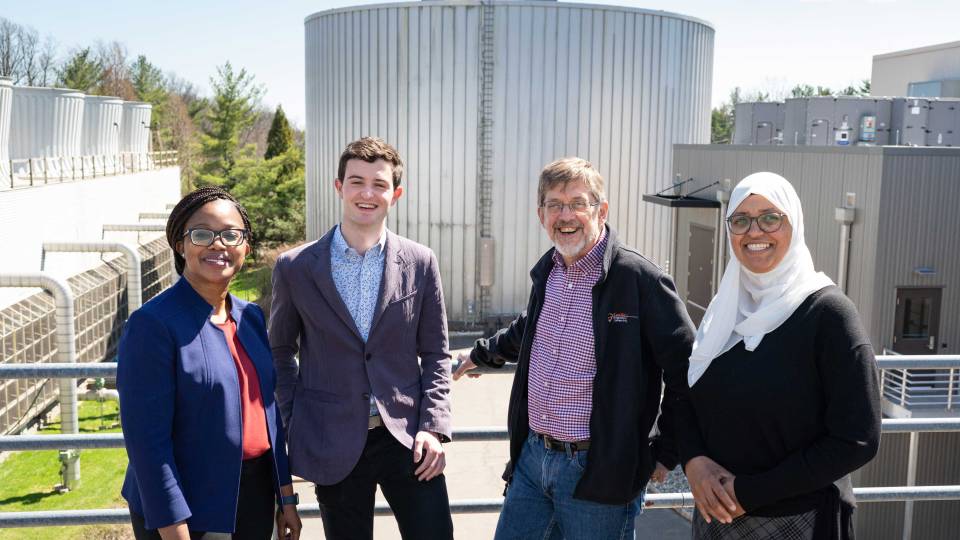As Princeton University undergoes one of the most extensive building programs in its history over the next decade, it is using the opportunity to lay the foundation needed to achieve “net-zero” greenhouse gas emissions before mid-century. Pictured are some of the many projects aimed at cutting emissions and improving sustainability including geo-exchange, energy efficient new buildings, building efficiency improvements, photovoltaic solar energy, electric vehicle charging stations and all-electric buses. A key identifying the icons is available at the end of the story.
Princeton University will undergo one of the most extensive building programs in its history over the next decade — adding some 3 million square feet in new construction to house more students, expand research facilities, and replace aging buildings and infrastructure.
The plans(Link is external) include new residential colleges to permit the University to increase its undergraduate student body by 10 percent; new facilities to support teaching and research in engineering and environmental studies; additional graduate student housing; added parking; and expanded athletic facilities, including a 2,100-seat soccer stadium and a racquet center with fitness space.
Construction on this scale could pose enormous sustainability challenges. Princeton, however, is embracing it as a once-in-a-generation opportunity to lay the foundation needed to achieve “net-zero” greenhouse gas emissions before mid-century.
“Princeton has pledged to reach net-zero by its 300th anniversary in 2046 without purchasing carbon offsets on the open market,” said Shana Weber, director of Princeton’s Office of Sustainability. “This means that we are taking responsibility for our own campus-based emissions and the actions necessary to reduce them directly. We want to demonstrate the kinds of infrastructure and planning changes that are necessary at a much larger scale than just the campus.”
Weber and others see the Princeton campus as a test bed for the kind of wholesale transition to sustainable practices and infrastructure that is critically needed at the national and global level.
Just last December, researchers at Princeton’s Andlinger Center for Energy and the Environment and High Meadows Environmental Institute made headlines(Link is external) at home and overseas for a comprehensive report called “Net-Zero America(Link is external).” In granular detail, the report mapped out the scope and scale of change necessary for the U.S. national economy to reach net-zero. Although they identified a variety of possible energy mixes, every scenario involved massive investments in energy efficiency, extensive electrification in transportation and buildings, energy storage and unprecedented expansion of clean energy production.
Princeton’s plan includes all of the above.

Princeton produces 4.5 megawatts of solar power through its 16,528 solar panels, located on 27 acres of University-owned land in West Windsor (pictured). By 2022, it will produce an additional 12 megawatts with new photovoltaic panels being installed on existing University properties, which will meet nearly 19% of the University’s annual electric demand.
“In many ways the Princeton capital plan is a net-zero transition exemplar,” said Chris Greig, who co-authored the report and is the Theodora D. ’78 & William H. Walton III ’74 Senior Research Scientist at the Andlinger Center for Energy and the Environment, and a lecturer in low-carbon energy transitions at the Andlinger Center. “Princeton’s investments in geo-exchange and heat pump technologies, building envelope improvements, solar panels and electric buses symbolize the actions that all U.S. institutions, companies and individuals must make in the decades ahead.”
Greig added, “The Net-Zero America study finds that the transition is quite affordable, but that it is capital intensive, as we mobilize low-carbon assets and infrastructure now, to avoid fuel and operating costs into the future.”
“The Net-Zero America report outlines beautifully where the most impactful actions are,” agrees Weber. “The key is we’re not waiting to act. We have to act now on information from these rigorous analyses so that deep emissions reductions are possible within the necessary timeframe.”
Geo-exchange and expanded solar
A lynchpin of the Princeton plan involves innovative energy facilities based on geo-exchange(Link is external).

Workers prepare to lower a drill into the earth that will dig out one of the hundreds of bores that comprise Princeton’s geo-exchange system. A large-scale system combining geo-exchange technology and thermal capture is a critical component in Princeton’s goal to achieve carbon neutrality by 2046.
After 250 years of using carbon-based heating technologies, Princeton is preparing to move to a new hot-water energy system driven by electric heat pumps, thermal storage and geo-exchange — one of the first in the nation to combine these technologies at this scale.
Princeton is installing a system of geo-exchange bores, which work like a thermal “piggy bank.” The system will remove heat from campus buildings during the summer and store it in the ground. During the winter, the same bores and rock around them will serve as a heat source for campus buildings.
Geo-exchange is part of a closed-loop system in which water is recirculated inside piping within deep bores in the earth. (On the Princeton Campus they will be 850 feet deep; on the Lakeside Campus in West Windsor, they will be 600 feet deep.) The piping is then surrounded by grout. The water circulating in the pipes never comes in direct contact with subterranean water sources or rock. The heat is transferred via conduction.
The new geo-exchange facilities, which will begin operations by 2023, will contribute significantly to reducing the University’s reliance on fossil fuels over time, using electrically driven heating and cooling heat pumps that eventually will be powered by carbon-free electricity from renewables, such as solar PV or wind.
“If we don’t do something differently today than we’ve been doing all along, we’re going to be well past the date when our climate scientists are saying things are going to crash and burn,” said Ted Borer, director of Princeton’s Energy Plant. “So, we need to invest today to solve these problems. Even if you don’t already see it as an immediate crisis, and personally I do, we have to get started because our investment will last longer than that.”
Some of Princeton’s renewable energy will be generated by solar panels(Link is external) owned and maintained by the University. To date, Princeton has installed 4.5 megawatts of solar power generating capacity through its 16,528 solar panels, located on 27 acres of University-owned land in West Windsor Township. “We’re actively putting another 12 megawatts in,” Borer said. “So, at lunchtime on a sunny April day, a nice cool day, we’ll probably have as much energy as we need for the whole campus.”
Energy needs in the northeastern United States fluctuate by season, so demand would be significantly higher on a hot day in July, for instance.
Borer said he expects nearly 19% of the University’s annual electric demand will be met by its solar capacity in 2022. Eventually, the University will purchase additional renewable power from other sources.

As Princeton undertakes a new building plan, which includes new residential colleges (shown) to increase its student population by 10%, it is using this once-in-a generation opportunity to lay the foundation to meet its net-zero emissions goals.
Energy efficient and low-carbon buildings
While creating more efficient energy systems and accessing cleaner energy supplies are critical, they are not enough to get Princeton to its ultimate target of net-zero. Energy usage must be significantly reduced(Link is external), as well, lightening the load and lessening the need for energy production.
“We need to use less energy, and we need to burn less stuff,” Borer said. “So, we need to make the buildings use less. So, tighten up, insulate more, air seal, basically make all of our building stock more efficient so they use less.”
New construction will be built to extremely high modern standards of energy efficiency, using an integrative design process (IDP). One manifestation of IDP is a plan to build an upcoming residential structure to Passive House(Link is external) standards, which will be the first of its kind on campus and that will inform future construction.
Passive House structures are built to exacting specification resulting in very well-insulated and well-sealed building envelopes, requiring far less heating and cooling inputs than standard construction allows. This approach also takes advantage of how buildings are oriented to the sun and prevailing wind, to take full advantage of “passive” heating and cooling, further enhancing the efficiency of the building.
In parallel with new construction, existing buildings on Princeton’s campus are being retrofitted to reduce their energy needs, including conversion from steam to hot water heating, replacing lighting with next-generation LEDs, installing advanced sensors and controls to turn off lights and air handling systems in unoccupied areas, and improving wall insulation and windows wherever feasible.
Another important area in reducing global carbon emissions is building materials. While the University is not directly responsible for the emissions from manufacturing processes, it has the ability to influence markets as a customer and therefore contributes to industry-wide carbon reductions. As Princeton builds, it is signaling to industry partners its desire to lower the “embodied” carbon associated with materials like concrete and steel.
As the most prevalent construction material in the world, concrete is responsible for between 8 and 10% of global carbon emissions. Informed by Princeton’s research expertise in sustainable concrete — led by Claire White, associate professor of civil and environmental engineering and the Andlinger Center for Energy and the Environment — discussions have already begun with regional manufacturers to explore using these cutting-edge technologies in the new generation of projects. Several upcoming building projects will also feature sustainably-sourced, glue-laminated wood structures as a replacement for structural steel, reducing the carbon footprint of the entire building.
Electrification of vehicles
Another major infrastructure shift that will contribute to Princeton’s net-zero emissions goal, again reflecting the national priorities outlined in the Net-Zero America report, is the conversion of the University’s entire bus fleet from diesel to electric in 2022.

The University’s entire bus fleet will shift from diesel to electric in 2022, significantly reducing carbon emitted into the atmosphere. Pictured: a bus from Tiger Transit’s transitional fleet, which will operate until the new EV buses arrive.
Making this type of wholesale conversion requires extensive planning and an upfront investment, but with many payoffs down the line, said Charlie Tennyson, Princeton’s interim director of parking and transportation services.
“What we want to share with people is that this is possible,” Tennyson added. “There is a formula to think about cost and operations.”
Princeton also is encouraging its employees and visitors to replace personal gasoline vehicles with electric by expanding beyond its current 20 EV charging stations and installing an additional 32 (that can charge up to 64 vehicles) in its upcoming East Garage(Link is external), to be constructed on part of the existing parking Lot 21. EV chargers also will be installed this summer at Princeton’s visitor lot, Lot 23.
This, paired with a comprehensive program to reduce the number of single-occupancy vehicles of any kind, and design for walking and bicycling, is part of a holistic sustainable approach to mobility.
As with much of the University’s new construction, the garage is designed to allow for a rooftop solar array to be added at a later date.
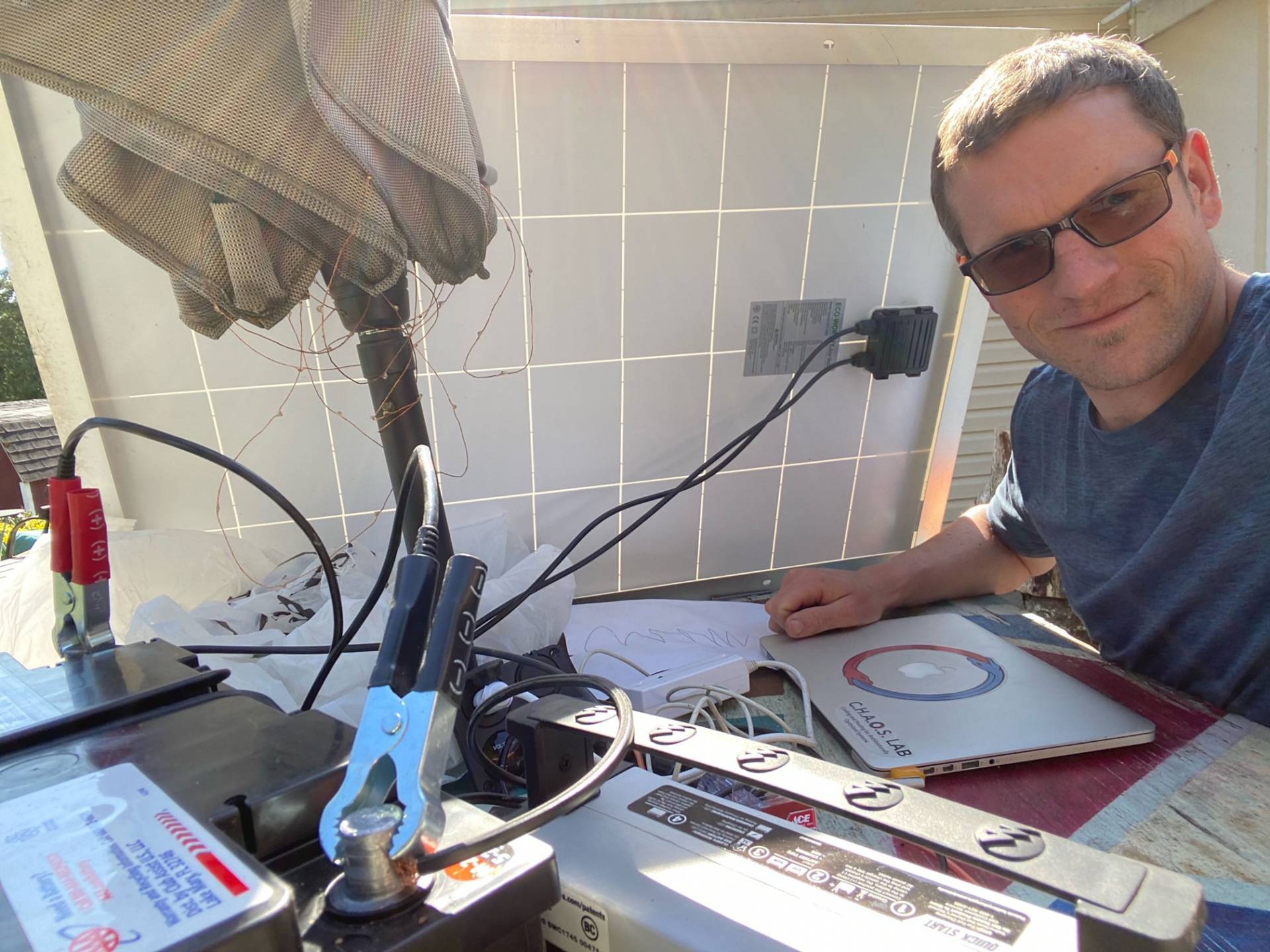
Forrest Meggers, assistant professor of architecture and the Andlinger Center for Energy and the Environment, and co-director of the Program in Architecture and Engineering, is among Princeton faculty who use the campus as a test bed for ideas in sustainability. Pictured: Meggers tinkers with photovoltaic solar panels at his outdoor “home office” to demonstrate their ease of use for his students this semester.
The human factor
While an upfront investment is required to enable this type of systemic change at Princeton, the long-term costs are affordable — a finding supported by the Net-Zero America report.
“You’re investing capital and trading longer-term operational and fuel costs,” Greig said. “So, it becomes a question of being really hard-nosed about your decisions.”
While the big investments are necessary, as is strong leadership to propel systemic change, there also needs to be movement from the ground up to reduce the scale of those investments, Greig said. That comes largely through behavioral change.
“One of us can’t make a difference. All of us have to,” Greig said. “I think the two go hand in glove. You need the leadership from the top, but we can help a lot. My argument is that this is such an enormous challenge that it’s going to take all of us to do everything we can.”
When sustainability action is simultaneously “top down” and “bottom up,” “we’re going to maximize our prospects of meeting our ambition and maybe even doing better,” Greig said.
Weber said changing our consumption behaviors and having awareness of the impact of those behaviors on communities around the world is by far the most challenging piece of the puzzle when it comes to sustainability. Princeton is launching an investigatory initiative into just this conundrum in collaboration with the company, Evidn(Link is external) — an Andlinger Center for Energy and the Environment E-filiate with behavioral science expertise.
“Technology will not save us if we continue to think of ourselves as purely extractive organisms on the planet,” Weber said. “We want to answer the question ‘just how much can we reduce campus energy usage through sustained individual changes in behavior, while we tackle the big infrastructure changes?’”
The campus and community as living lab
The construction program at Princeton won’t just test existing ideas in sustainability, it also will deliver data for researchers conducting ongoing work on sustainability questions.
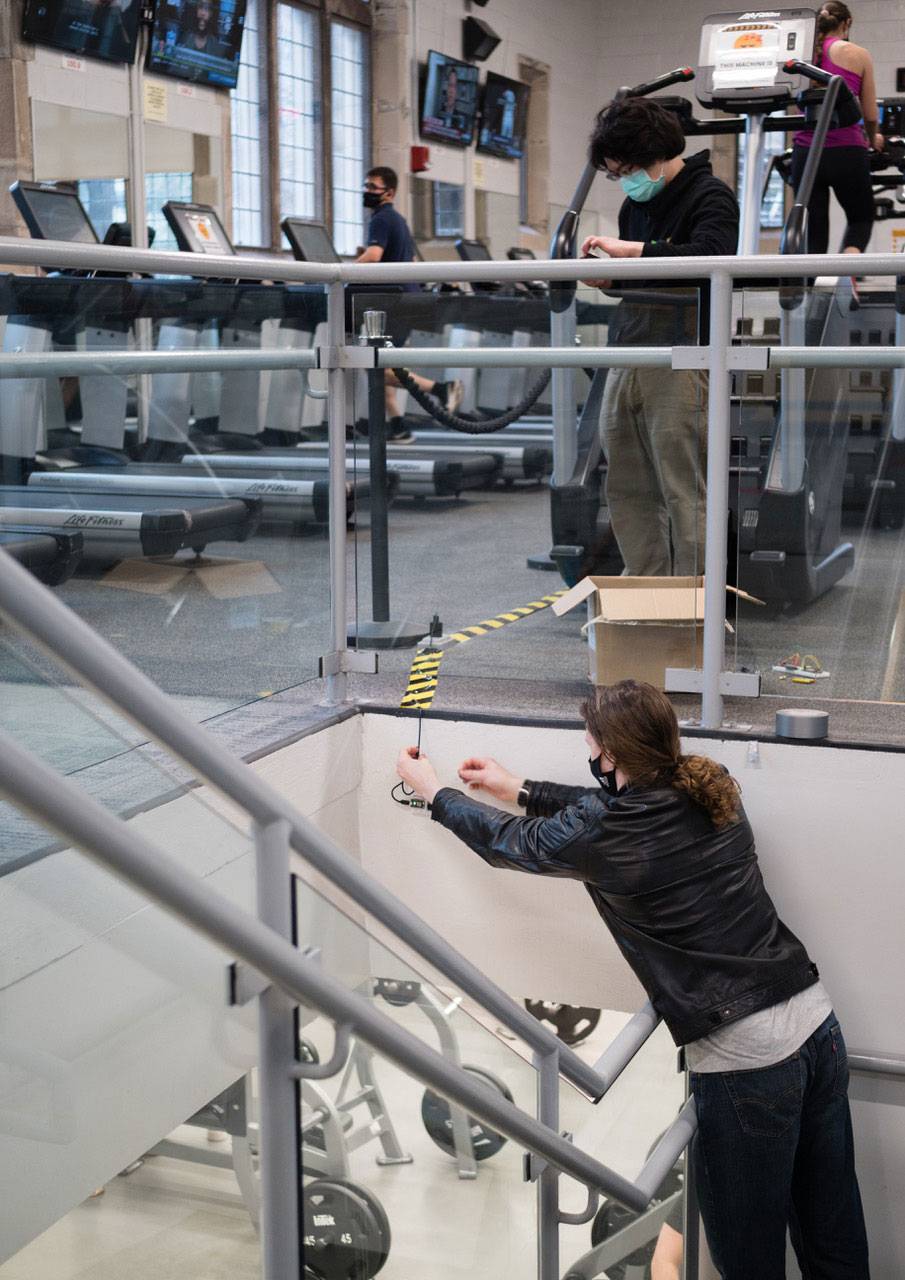
Kian Wee Chen (standing, in mask), a postdoctoral research associate in the Andlinger Center for Energy and the Environment, and Nick Sudarsky (on stair landing), Class of 2023, install sensors in Dillon Gym to monitor air quality as part of a project with Forrest Meggers.
Princeton’s campus has long served as a test bed for all manner of sustainable practices. For instance, researchers study existing data from University Facilities — hundreds of thousands of data points measuring everything from indoor temperature to air quality to energy usage — and use their findings to inform Princeton’s sustainability efforts, as well as their own studies.
Some, like Forrest Meggers, assistant professor of architecture and the Andlinger Center for Energy and the Environment, and co-director of the Program in Architecture and Engineering, has deployed his lab’s sensors by the hundreds to study and test buildings(Link is external) and their efficiency.
“One of the ways in which Princeton is leading and supporting innovative ways to use data is by working with Facilities and their data,” Meggers said. “It’s not as exciting as building a huge solar field or the geo-exchange, but actually, a really important underlying infrastructure element is data.”
Once Princeton’s bus fleet is fully electrified and managed digitally, it will churn out mounds of data for students, faculty and staff to investigate.
Said Tennyson: “We already have had students come to us with requests for the real-time transit feeds or any number of other things around sustainability. We want to be an open partner. It’s a great model deployment to study, and we hope someone will.”
Amanda Stevens, commute options manager for Transportation and Parking Services, said the benefits to that type of study are many and mutual. They also will assist others as they begin to make similar energy transitions.
New Jersey’s state government has pushed aggressive electric vehicle targets(Link is external) and is starting to build out programs to support public charging and public agency fleet transitions, Stevens said. New Jersey Transit recently announced its Camden routes will deploy eight new electric buses(Link is external).
“We will make this project available in any way the state might need,” Stevens said. “We’re going to be operating an electric vehicle fleet on the ground in the next two years, and we’re going to be learning regardless. If we can be helpful to the state effort, then we should make ourselves available for that.”
Bringing together student and faculty researchers, operations professionals, technical experts and outside organizations that might benefit from Princeton’s learning in productive and meaningful ways is no small task. To manage these collaborations and partnerships, Princeton has a dedicated “campus as lab” manager, a position currently held by Ijeoma Nwagwu.
“We see this research as teachable moments for us on campus” said Nwagwu, assistant director for academic engagement and campus as lab initiatives in the Office of Sustainability. “None is the same, but what’s common to them all is that convergence of academic work, the teaching and the research, operations, and broader campus engagement.”
Nwagwu said it is the convening of these conversations and interactions that can lead to the greatest innovation and creativity, especially given the diverse background and interests of the various parties at the table.
“There’s a high level of collaboration and lateral thinking that just bursts,” she said. “It’s a unique interaction that makes Princeton, Princeton. This kind of interaction makes it possible to push the boundaries of knowledge.”
When the silos are removed from knowledge and collaborative thinking is at work, it’s especially powerful for students to witness, Nwagwu said.
“I think it’s really significant from an educational standpoint, because it provides our students with the unique experience of developing a sustainability ethos, not as something that is theoretical, but as something that is practical,” she said. “So when we have these opportunities, it also provides a platform to what I think is the best kind of learning: experiential learning.”
“I think what makes the hard work of sustainability really worth it here is that we are really committed,” she added. “Everybody feels that passion, that we want to do this, and we want to be at the forefront of innovations that drive sustainability. We emphasize scalability and replicability, so we’re not just doing these projects on campus for us. It’s really for the world. These are things that can answer very urgent global sustainability problems.”
A model for sustainability
One of Princeton’s core sustainability planning principles, as outlined in its Sustainability Action Plan, is to assess options for their repeatability and scalability beyond the campus. It is Princeton’s intent to strongly contribute to advancing sustainable solutions broadly in both innovative and very applicable ways, in partnership with many other institutions, sectors and organizations.
Borer said simply getting started can seem challenging, especially when implementing an entirely new system, like geo-exchange.
“It’s enormously exhausting, it feels impossible, but it’s necessary,” Borer said. “It’s not always elegant either. In any given meeting, I think a lot of us are frustrated: Why can’t we do this any faster? Why can’t we do this more efficiently? But then after we step back, a lot of us say, ‘oh my goodness, look at all these people whose expertise and effort we coordinated.’”
What works on Princeton’s campus won’t translate perfectly for others, given their size, regulatory guidelines, resources and — perhaps, above all — the climate in which they are located, which significantly impacts heating and cooling needs, and thus, their energy requirements.
“We’re not going to tell a university in Utah or Texas to do what we’ve done,” Borer said. “But we will tell them: ‘Look at our thought process. Look at what we did with University planning. Then look at what we did with campus planning. Then look what we did with energy infrastructure planning. Look at that thought process.’ I think they will come to their own best solution that way.”
Weber echoed that sentiment, lauding Princeton for its implementation of an integrative design process. Community, collaboration and coalition-building are essential to the sustainability endeavor, she said.
“To do that deeply requires exactly what the name implies — it’s a truly integrative process where you put all the ideas, bring all the expertise together at the beginning of the process, and you agree on a vision for the project, including sustainability,” Weber said. “From what I’ve seen we’re helping to forge some new ground there. The other thing I think we do exceptionally well is convene conversations between our expert researchers and our practitioners.”
Princeton’s faculty, she noted, “have been extraordinarily open with dialogue and generous with their time and interested in how the campus stewards itself. They’re teaching, they’re doing research in many of these critical global challenge areas, and they have expressed more and more interest over time in seeing how Princeton as a place is grappling with those same issues on the ground.”
Weber said she especially enjoys seeing students in the mix, solving problems they, too, must eventually face. “They start thinking about these issues in the classroom, and then see the campus tinkering with the same challenges,” she said. “That’s a phenomenal learning environment. Engaging the students in that problem-solving process is something students crave and something we can provide. The campus-as-living-lab approach is something we are particularly well-suited for at Princeton.”
The process might seem messy and imperfect at times as new practices are explored through experimentation and research, but the ultimate objective is clear, Weber said.
“Many of our faculty who study climate issues from multiple disciplines, including economics, stress that it’s more important to act early than to wait for the perfect technology or the cheapest technology,” Weber said. “There are things we can do today that are cost effective. We need to do them. Every ton of carbon emitted now has implications for centuries. So the longer we wait, the more critical the issue becomes globally.”

The map above gives an overview of some of Princeton University’s many projects aimed at cutting carbon emissions and improving sustainability. Blue lightning bolt: EV charging station. Blue bus: All-electric buses. Orange thermometer: Geo-exchange. Yellow sun and panel: Photovoltaic solar energy. Green house: New energy efficient construction. Purple lightbulb: Energy efficient building retrofits.

